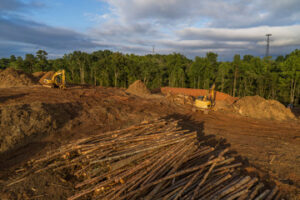Land Clearing is important for a number of reasons. It helps trees and other plants grow by ensuring they have access to water and sunlight. It also prevents soil erosion by removing excess vegetation.

Professionals use techniques that minimize environmental impact and comply with local regulations. Costs vary depending on factors such as size of the land, type and density of vegetation and terrain.
A significant part of land clearing involves removing unwanted or dangerous vegetation. This includes trees and stumps, undergrowth, brush and more. It’s essential for creating an area suitable for farming or building. During the clearing process, the goal is to leave only that which is necessary for the desired purpose of the land.
The first step in the process is to make a thorough evaluation of the land. This will allow you to understand the topography, soil composition, wildlife habitats and types of native vegetation. This will help you choose the most effective clearing method and anticipate challenges.
There are several methods of clearing, including using herbicides to kill plants or allowing natural processes to remove vegetation over time. Another option is to use heavy machinery, like bulldozers or excavators. This can be faster and more effective than manual labor, but it’s not ideal for fragile ecosystems or steep slopes.
Once you’ve determined the most effective method for your land, the next step is to clear the actual site. This may include tearing down and hauling away old structures, digging out or breaking up concrete foundations and removing other debris. Renting a dumpster is often the easiest way to dispose of this debris.
It’s important to take steps to prevent erosion during the clearing process. Erosion can cause damage to nearby lakes, rivers or streams, which can be costly and difficult to clean up. The best practice for minimizing erosion is through the use of sediment control techniques, such as the placement of mulch and other organic material on the site, which helps stabilize the soil and prevent runoff.
Maintaining an appropriate level of vegetation on your property also protects against pests and other nuisances. Dense areas of overgrowth provide natural shelter and nourishment for mosquitoes, gnats, hornets and other annoying insects. Clearing dense overgrowth on your property will reduce these pest populations, ensuring you can enjoy the outdoors without worrying about pests. Additionally, cleared land is more visually appealing and can boost your property’s value. This is particularly true if you’re planning to sell your property in the future.
Preparing for Development
A primary goal of land clearing is preparing the site for development, which requires a comprehensive approach to evaluating the terrain and vegetation. This preparation is most effective when done in a way that balances speed with environmental concerns and sustainability goals. Achieving this goal is possible through a combination of advanced machinery and experienced professionals. Land clearing professionals use bulldozers, excavators, and tree shears to cut down large trees and clear dense brush quickly and efficiently.
It is also important to consider zoning regulations and permits before starting the land clearing process. This step ensures compliance with local laws and minimizes the risk of legal issues later on in the project. Additionally, it is important to evaluate the availability of infrastructure and utilities such as water, electricity, sewer, and road access.
Once the necessary infrastructure is in place, land clearing can begin. It is often best to start this process during times when plants are dormant, such as late spring through summer or fall. This will prevent interference with existing vegetation and minimize the chances of encountering poison oak and other common plant toxins.
In addition to removing trees and other vegetation, land clearing may include soil testing, debris removal, leveling the site, and other preparations for future construction or agricultural activities. It is also important to implement erosion control measures during and after clearing the site to protect the environment from sediment runoff and environmental damage.
The most effective way to prepare a site for development during land clearing is to develop a detailed plan and schedule that incorporates all the steps needed to achieve the desired outcome. This plan will help determine the equipment and resources needed to clear the land as well as the expected timeline.
It is also helpful to consult with experts in the field of land clearing to develop a thorough plan that addresses all aspects of the project. Their experience and knowledge of the regulations will ensure that the project is completed as quickly and efficiently as possible while meeting all the required requirements.
Removing Hazards
Land clearing is essential to preparing property for construction, agriculture, or landscaping. It removes invasive vegetation, improves soil quality, and provides an even surface for building or planting. It also eliminates the risk of structural damage caused by overgrown trees, debris, and rotting stumps. It can also reduce the risk of flooding by preventing erosion and sedimentation in nearby water bodies. It’s important to clear only what is necessary, as over-clearing can have negative impacts on the environment and surrounding communities.
Prior to starting the project, it’s best to contact utility companies to ensure that you aren’t interrupting any underground lines. You should also mark any areas that are protected or contain trees, structures, or other features that should not be removed. It’s a good idea to also consult with the zoning or building departments and protective covenants for the area before beginning any work.
Workers should be given proper training and safety equipment to protect themselves during land clearing activities. This includes hard hats and safety goggles. It’s also important to perform thorough risk assessments before starting any work to identify potential hazards, such as unstable slopes or hidden underground utilities.
Once the vegetation and debris are cleared, the next step in land clearing is grading. This involves leveling the land to create a smooth, stable surface for construction, agriculture, or landscaping projects. It can be done manually or with specialized machinery.
It’s vital to take the time to do this right, as it can greatly improve the overall appearance and functionality of a property. It can also make a property more attractive to prospective buyers.
Responsible land clearing isn’t just a legal requirement, but a moral responsibility. By adhering to strict safety protocols, we can minimize accidents and environmental incidents, fostering a safer community environment for everyone involved. We can also minimize the impact that clearing operations have on the environment by avoiding soil runoff, habitat destruction, and other harmful effects. Safety measures also help prevent accidents that could harm nearby residents and their properties by ensuring that workers have the proper equipment and protection to complete their jobs safely.
Preserving the Environment
When it comes to land clearing, it’s important for property owners to be aware of the surrounding environment. This includes not only identifying potential hazards like unstable ground or overhead power lines but also determining what features should remain untouched, such as larger trees and shrubs with complex root systems. Clearly marking these areas with signs or fencing can help to prevent accidental removal during the land clearing process. It’s also wise to check with zoning and building departments as well as protective covenants before beginning the project.
Land Clearing can also preserve the environment by removing harmful plants that choke out native species, and encouraging the growth of healthy vegetation and trees. By using precision machinery and expert methods, this allows ecosystems to be revitalized without harming soil fertility or waterways.
In addition, sustainable clearing practices protect human life by minimizing the risk of accidents and environmental incidents. By following safety protocols, ensuring proper training for all workers and adhering to strict environmental regulations, the likelihood of injuries and ecological damage can be reduced.
It’s also vital to consider the impact that land clearing has on local and international wildlife, plant and animal populations. Inappropriate methods can lead to habitat degradation, deforestation and desertification. However, by adhering to international environmental treaties and fostering reforestation, land clearing can be done responsibly while benefiting the world’s ecosystems.
Finally, land clearing can preserve the environment by promoting a healthy environment for agricultural and commercial uses. Overgrown plots of land can be hard for crops and animals to grow on, but leveling the land can open up opportunities for farmers and developers. Land clearing can even improve the value of homes and businesses by enlarging their aesthetic appeal. If you’re ready to begin the land clearing process on your property, contact a professional that specializes in sustainable techniques that don’t damage or destroy the natural environment. They can provide you with the tools and resources needed to get the job done quickly and efficiently. This ensures that the land is properly prepared for its intended use and provides lasting benefits for years to come.


